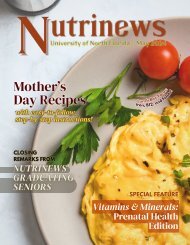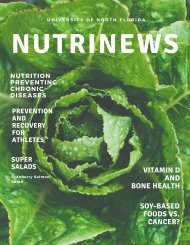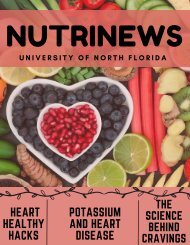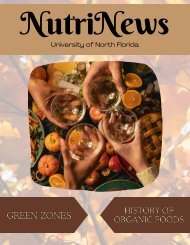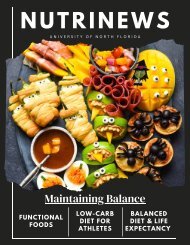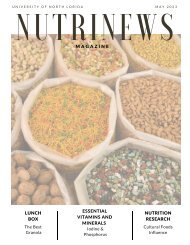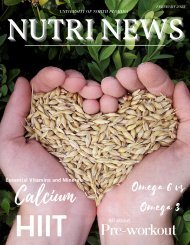Nutri News September 2022
The theme for September is Back to School!!! Articles include nutrigenetics and if a nutrient dense breakfast improves school performance. This issue also includes an easy lunch box recipe and shopping in season with figs. This month’s student spotlight is on our very own Georgina Brace and an interview with Professor Altice.
The theme for September is Back to School!!! Articles include nutrigenetics and if a nutrient dense breakfast improves school performance. This issue also includes an easy lunch box recipe and shopping in season with figs. This month’s student spotlight is on our very own Georgina Brace and an interview with Professor Altice.
Create successful ePaper yourself
Turn your PDF publications into a flip-book with our unique Google optimized e-Paper software.
18<br />
Written by: Alicia Scott<br />
All About<br />
Figs<br />
Adriatic Figs<br />
Figs are said to originate from Western Asia and can<br />
be traced back to 5,000 BC. The fig tells a complex<br />
symbolic story in culinary history because it was used<br />
to sweeten dishes before the widespread use of<br />
sugar.1 The fig tree was introduced in the New World<br />
through Mexico in 1560 and one of the most popular<br />
commercial products since then has been Fig<br />
Newtons which were developed in 1891.1 One of the<br />
most interesting things about figs is that the fruit of<br />
the plant is an inverted flower. The fig tree is<br />
respected and even sacred in certain religions such<br />
as Islam where it is one of the two most sacred trees<br />
of the religion.2 In other religions such as<br />
Christianity, Hinduism, and others, it is seen as a sign<br />
of peace, fertility, and prosperity.1<br />
There are well over 700 different varieties of figs<br />
however, there are nine varieties that are more<br />
known than the others, and here are the top five<br />
varieties within those nine. The first variety is<br />
Celeste, this variety is pear-shaped, with purplish<br />
skin and the pulp is more of white or pink color.3 The<br />
flavor profile is excellent, and it is almost seedless.<br />
The second variety is Brown Turkey, and this variety<br />
has a broader shape than the Celeste with coppercolored<br />
skin and the pulp can go from a white color<br />
to a light red. This variety can thrive in warmer<br />
climates and can be found growing all over<br />
Hawaii.3 Brunswick otherwise called Magnolia is<br />
another variety and compared to the other two<br />
mentioned, it has a narrow lobed shape with a<br />
bronze or purple-brown color. Leaving the more<br />
purple color family, Marseilles otherwise called<br />
Lemon is known for its yellow-green color and round<br />
shape with large seeds.3 In the yellow-green color<br />
family, there is the Adriatic variety with a distinct<br />
flavor and good quality, and this variety is known for<br />
its turbinate shape with a thick, short neck.<br />
Celeste Figs<br />
Brunswick Figs




